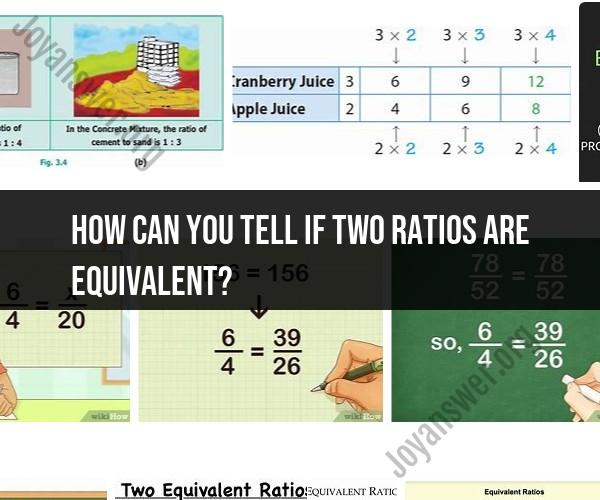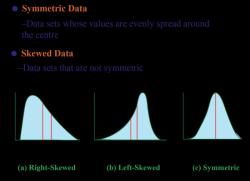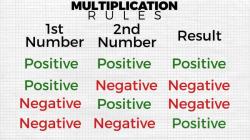How can you tell if two ratios are equivalent?
Two ratios are considered equivalent if they represent the same relationship between quantities, even though the specific numbers in the ratios may differ. You can determine if two ratios are equivalent by simplifying or reducing them to their simplest form and then comparing the simplified ratios. Here are the steps to tell if two ratios are equivalent:
Step 1: Simplify Each Ratio:
- Simplify each ratio by dividing both the numerator (top number) and the denominator (bottom number) by their greatest common divisor (GCD) or greatest common factor (GCF). This process reduces the ratio to its simplest form.
Step 2: Compare the Simplified Ratios:
- After simplifying both ratios, compare the simplified ratios to see if they are the same. If the simplified ratios are equal, then the original ratios are equivalent.
Step 3: Use Cross-Multiplication (Optional):
- Another way to compare ratios is to use cross-multiplication. Cross-multiplication involves multiplying the numerator of one ratio by the denominator of the other ratio and vice versa. If the results are equal, the ratios are equivalent. For example, if you have the ratios A/B and C/D, you can check if they are equivalent using cross-multiplication by verifying whether AD = BC.
Example:Suppose you have the ratios 4/8 and 3/6, and you want to determine if they are equivalent:
Step 1 (Simplify the Ratios):
Simplify the first ratio, 4/8, by dividing both the numerator and the denominator by their GCF, which is 4. This simplifies to 1/2.
Simplify the second ratio, 3/6, by dividing both the numerator and the denominator by their GCF, which is 3. This also simplifies to 1/2.
Step 2 (Compare the Simplified Ratios):
- Since both simplified ratios are 1/2, the original ratios, 4/8 and 3/6, are equivalent.
In this case, by simplifying the ratios to their simplest form and comparing them, you can conclude that 4/8 and 3/6 are equivalent ratios.
The concept of equivalent ratios is important in various mathematical and real-world applications, including proportionality, scaling, and solving problems involving ratios and proportions.
Ratios and Equivalence: How to Determine Equality
A ratio is a comparison of two quantities. It can be written in a few different ways, such as:
a:ba/b"a" to "b"
Equivalence is a relationship between two ratios that means they have the same value.
To determine if two ratios are equivalent, you can multiply or divide both parts of each ratio by the same number. For example, the ratios 1:2 and 2:4 are equivalent because you can multiply both parts of the first ratio by 2 to get the second ratio.
Another way to determine if two ratios are equivalent is to cross-multiply. To do this, multiply the numerator of the first ratio by the denominator of the second ratio, and multiply the denominator of the first ratio by the numerator of the second ratio. If the two products are equal, then the ratios are equivalent. For example, the ratios 1:2 and 2:4 are equivalent because the cross products are equal:
(1)(4) = (2)(2)
Ratios and Equivalency: Unraveling the Connection
Ratios and equivalence are closely related concepts. Ratios are used to represent relationships between quantities, and equivalence is used to compare the values of those relationships.
Ratios can be used to represent a wide variety of relationships, such as:
- The ratio of the length to the width of a rectangle
- The ratio of the number of boys to the number of girls in a class
- The ratio of the price of one item to the price of another item
- The ratio of the distance traveled to the time spent traveling
Equivalence can be used to compare the values of any two ratios. For example, you can use equivalence to compare the ratios of the length to the width of two different rectangles, or the ratios of the number of boys to the number of girls in two different classes.
Are These Ratios Equivalent? Discovering Mathematical Equality
To determine if two ratios are equivalent, you can use the methods described above. For example, to determine if the ratios 1:2 and 3:6 are equivalent, you can multiply both parts of the first ratio by 3 to get the second ratio:
(1)(3) = 3
(2)(3) = 6
Therefore, the ratios 1:2 and 3:6 are equivalent.
Here are some other examples of equivalent ratios:
1:2 = 2:4 = 3:6 = 4:8
5:10 = 1:2 = 2:4
1/2 = 2/4 = 3/6 = 4/8
Ratios and equivalence are important concepts in mathematics, and they have many applications in the real world. By understanding these concepts, we can better understand the world around us and make better decisions.













